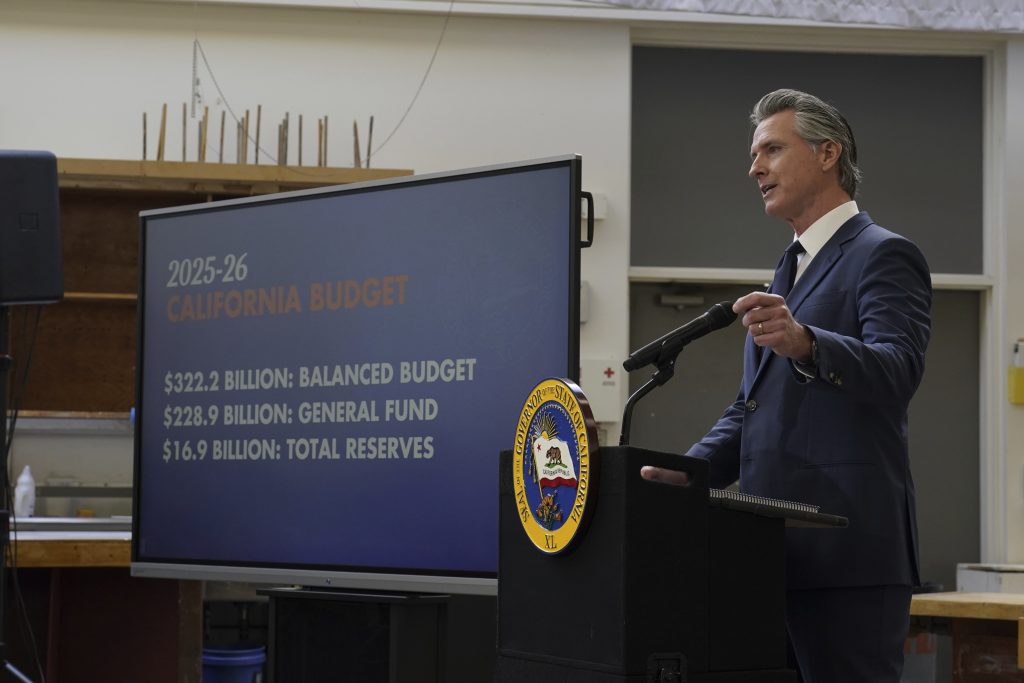
Let’s Talk… About California’s January State Budget
Demystifying the Budget Process
January 31, 2025
Governor Newsom’s January 2025 State Budget Proposal
The California state budget proposal released by Governor Newsom earlier this month encompasses more than $322 billion in total state government spending across more than 200 agencies, commissions, programs, and other public entities. The printed bill containing the legislative language for the Governor’s proposal is 836 pages long, containing more than 1,000 line items appropriating state funds. The massive scale and complexity of California’s annual spending plan understandably leaves many Californians confused about how to follow the development and adoption of the state budget each year, let alone how to directly engage and provide input into the process.
Whether it’s sticking to a New Year’s resolution or returning to school after a long winter break, each January invites us to tackle challenges that, although daunting in the near-term, provide long-term benefits. In that spirit, this edition of NextGen’s Let’s Talk blog seeks to make the task of understanding California’s January budget proposal a little less forbidding while also providing insights into how to engage in California’s budget process.
What is the January Budget Proposal?
The California Constitution (Article IV, Section 12) requires, within the first 10 days of each year, that a Governor must submit to the Legislature a budget for the upcoming fiscal year. The January budget proposal functions primarily as a tool that Governors use to express their values as well as frame and set the terms of debate over the upcoming fiscal year’s budget. The Legislature generally uses the Governor’s proposals as the basis to start its deliberations over the upcoming year’s budget. So, the January proposal plays an important role in advancing fiscal policy changes that the Governor chooses to prioritize, which could include funding for new programs, reallocations of existing funding among different programs, reductions in spending to address a deficit, and proposals to increase or decrease state revenues.
The Governor’s January proposal reflects months of behind-the-scenes work by the Department of Finance, state agency staff, and others to develop budget plans for the coming fiscal year. While the Governor’s January budget proposal may not, strictly speaking, mark the beginning of the budget process, it does begin a vital phase of the annual budget cycle, during which the public has the most opportunity to directly engage with budget policymakers.

Following the submission of the Governor’s January budget, the Legislature begins the process of analyzing the proposal. This process typically extends from mid-January until mid-May. Unlike other phases of the budget cycle, in which much of the activity is less visible to the public, this period between mid-January and mid-May is the prime opportunity for all Californians to learn about, and weigh-in on, plans for the state’s upcoming fiscal year. This part of the cycle includes a variety of important elements including: releases of budget-related information by the Department of Finance, introduction of budget bills in each house of the Legislature, summaries and overview hearings by the Senate and Assembly budget committees, analyses prepared by the Legislative Analyst’s Office (LAO), and detailed budget analyses and hearings by budget subcommittees. Below, we’ll take a brief look at each of these elements to understand how they fit into the process and what opportunities they present for the public to engage with the budget.
January Budget Proposal – Elements of the Process
There are a variety of tools and resources that are valuable to anyone seeking to understand California’s annual January budget, including:
Department of Finance’s website – The place to start, when trying to understand the January Budget proposal, is to look at the summaries of the proposal that are posted on the Department of Finance’s budget website. That site links to both a relatively brief summary document, which explains the broad elements of the January proposal, as well as an extensive and detailed breakdown of the entire budget, organized by state agency, department, and program.
After the January 10 budget release, the Department of Finance continues to produce important budget-related documents that help to flesh-out details of the Governor’s proposals. Among these helpful resources is information about trailer bills, which are legislative proposals that make statutory changes needed to implement the proposed budget. It can also be useful to look at budget change proposals, which provide details about proposed new programs or changes to previously authorized programs.
Budget Bills – The Chairs of the Senate and Assembly Budget Committees introduce bills that reflect the details of the Governor’s proposed budget. This year, the budget bills are AB 227 (Gabriel) and SB 65 (Wiener). In addition to containing all of the appropriations that comprise the Governor’s budget, the budget bills contain so-called “control language” that often describes certain limits or conditions that apply to the expenditure of funds appropriated in the budget.
Legislative Analyst’s Office – The Legislative Analyst’s Office produces numerous reports analyzing elements of the Governor’s budget proposal. The LAO’s overview summary of this year’s proposal has already been released. Subsequent reports on specific issue areas and programs will be posted to the budget section of the LAO’s website.
Legislative Budget Committees – Brief summaries of the Governor’s budget proposal, organized by issue area, are written by the staff at the Assembly Budget Committee and Senate Budget and Fiscal Review Committee. In mid-to-late January, the committees hold overview hearings on the Governor’s budget, at which representatives from the Department of Finance, the Legislative Analyst’s Office, and some state agencies are asked to testify and answer Legislators’ questions. These are public hearings which can be attended in person or viewed through a webcast. The dates, times, and agendas for these hearings, along with links to the broadcasts, can be found on the respective websites for the Senate and Assembly committees.
Budget Subcommittees – The most important legislative work on the January budget proposal happens in the Assembly and Senate budget subcommittees. In each house, subcommittees are organized around broad issue areas and assigned numbers. For example, in the Senate, the budget subcommittee responsible for education funding is Subcommittee 1 and in the Assembly budget Subcommittee 3 handles education funding. Complete lists of the subcommittees and their jurisdictions can be found on the Senate and Assembly budget committee websites.
Beginning in February, these subcommittees will hold a series of public hearings on the various elements of the budget under their jurisdictions. They will produce detailed analyses of the proposed budget and staff will consider which budget items to approve, change, reject, or leave open for action at a later date. The subcommittee hearings are the primary opportunity for Californians to directly address budget policymakers to express their views on budget proposals. As a result, it is important to monitor the subcommittee websites to know what budget items each subcommittee will be discussing at upcoming hearings and to read the committee staff’s analysis of those items. These hearings are also an opportunity to attend and make a statement about budget items, whether you’re in support, opposed or have suggested changes to them.
How Will NextGen Engage With the January Budget?
We can use one of the priority issue areas that NextGen will be monitoring in this year’s budget to more clearly illustrate how the elements described above can be used to engage with the state budget process.

Our staff working on food insecurity issues has reviewed the Department of Finance’s summary and detail of the January budget to identify funding items that we plan to support in the coming budget process. For example, NextGen plans to support the proposal for $150 million in one-time funding for schools to procure specialized kitchen equipment and deliver training to provide more healthy and freshly prepared school meals. Additionally, NextGen will be advocating for continued funding to support the California Healthy School Food Pathways Program. This budget request seeks funding, over the next three years, to continue workforce training and retention programs that support the school food professionals who are critical to providing California students with healthy school meals. To advance these priorities, over the next few months, our staff will:
- Read through LAO reports, committee summaries, and subcommittee analyses on education funding to look for any discussion of this kitchen infrastructure funding, looking particularly for any concerns or suggested alternatives that may be identified,
- Check for any trailer bill language that may propose changes to the statutes governing how schools procure kitchen infrastructure,
- Monitor the websites of the education budget subcommittees for advance notice of when the public hearings discussing this spending proposal will be held and submit in writing or attend in-person our public comments on these proposals.
All of the above steps will keep us prepared to engage directly with Legislators, the Governor’s Office, agency staff, and other stakeholders in support of this proposal. This engagement can include support letters, face-to-face meetings, and public testimony at hearings. Similar efforts will be taken by our staff working on other NextGen priority issue areas, including climate, higher education, workforce development, and digital equity.
Whatever your interest in the state budget process may be, we hope that the above resources and explanations help motivate you to engage more deeply in the 2025 state budget process. At the very least you can always call your representatives and let them know your thoughts on a budget item. No matter how difficult it may seem, we’ll all be better off when more people are involved in the important decisions about how to allocate state funding to advance all Californians’ well-being and best interests.
Thanks for reading,
Brian Weinberger
